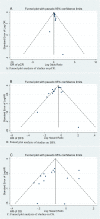Predictive and prognostic role of tumour-infiltrating lymphocytes in breast cancer patients with different molecular subtypes: a meta-analysis
- PMID: 33238978
- PMCID: PMC7690150
- DOI: 10.1186/s12885-020-07654-y
Predictive and prognostic role of tumour-infiltrating lymphocytes in breast cancer patients with different molecular subtypes: a meta-analysis
Abstract
Background: Whether tumour-infiltrating lymphocytes (TILs) play different roles in different molecular subtypes of breast cancer remains unknown. Additionally, their prognostic and predictive value in different molecular subtypes of breast cancer is still controversial. The aim of our meta-analysis was to assess the prognostic and predictive value of TILs in different molecular subtypes of breast cancer by summarizing all relevant studies performing multivariate analysis.
Methods: PubMed, Embase, EBSCO, ScienceDirect, the Cochrane Database and Web of Science were comprehensively searched (until March 2020). Hazard ratios (HRs), odds ratios (ORs) and their 95% confidence intervals (CIs) were used as effect measures to perform our meta-analysis. A random effect model was used. Stata software, version 15 (2017) (StataCorp, College Station, TX, USA) was used to perform the statistical analysis.
Results: Thirty-three studies including 18,170 eligible breast cancer patients were analysed. The meta-analysis showed that high TIL expression was significantly associated with increased pathological complete response (pCR) rates after neoadjuvant chemotherapy in patients with the HER2-enriched molecular subtype (OR = 1.137, 95% CI [1.061 ~ 1.218], p < 0.001) and triple-negative breast cancer (TNBC) subtype (OR = 1.120, 95% CI [1.061 ~ 1.182], p < 0.001). However, high TIL expression was not significantly associated with high pCR rates after neoadjuvant chemotherapy in patients with the luminal molecular subtype of breast cancer (OR = 1.154, 95% CI [0.789 ~ 1.690], p = 0.460). We carried out a meta-analysis on the HRs of overall survival (OS) and disease-free survival (DFS) to assess the prognostic value of TILs in breast cancer with different molecular subtypes more deeply. Our meta-analysis confirmed that high TILs were associated with significantly improved DFS in patients with the HER2-enriched molecular subtype [HR = 0.940, 95% CI (0.903 ~ 0.979), p = 0.003] and TNBC molecular subtype [HR = 0.907, 95% CI (0.862 ~ 0.954), p < 0.001]. However, high TILs were not associated with significantly better DFS in patients with the luminal molecular subtype of breast cancer [HR = 0.998, 95% CI (0.977 ~ 1.019), p = 0.840]. Furthermore, the results confirmed that high TILs were significantly related to better OS in patients with the HER2-enriched molecular subtype [HR = 0.910, 95% CI (0.866 ~ 0.957), p < 0.001] and TNBC molecular subtype [HR = 0.869, 95% CI (0.836 ~ 0.904), p < 0.001]. Conversely, the summarized results indicated that high TILs were significantly associated with poor OS in patients with the luminal molecular subtype of breast cancer [HR = 1.077, 95% CI (1.016 ~ 1.141), p = 0.012].
Conclusions: Our meta-analysis confirms that high TILs are associated with favourable survival and predicts pCR in breast cancer patients with the TNBC and HER2-enriched molecular subtypes.
Keywords: Breast cancer; Meta-analysis; Molecular subtype; Prediction; Prognosis; Tumour-infiltrating lymphocytes.
Conflict of interest statement
The authors declare that they have no confict of interest.
Figures
References
-
- Denkert C, Loibl S, Noske A, Roller M, Muller BM, Komor M, Budczies J, Darb-Esfahani S, Kronenwett R, Hanusch C, et al. Tumor-associated lymphocytes as an independent predictor of response to neoadjuvant chemotherapy in breast cancer. J Clin Oncol. 2010;28(1):105–113. doi: 10.1200/JCO.2009.23.7370. - DOI - PubMed
-
- Loi S, Sirtaine N, Piette F, Salgado R, Viale G, Van Eenoo F, Rouas G, Francis P, Crown JP, Hitre E, et al. Prognostic and predictive value of tumor-infiltrating lymphocytes in a phase III randomized adjuvant breast cancer trial in node-positive breast cancer comparing the addition of docetaxel to doxorubicin with doxorubicin-based chemotherapy: BIG 02-98. J Clin Oncol. 2013;31(7):860–867. doi: 10.1200/JCO.2011.41.0902. - DOI - PubMed
Publication types
MeSH terms
Substances
LinkOut - more resources
Full Text Sources
Medical
Research Materials
Miscellaneous






